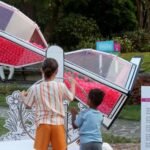Developed by Yorkshire Wildlife Trust and Invisible Dust, Wild Eye is a bold and imaginative project that brings together large-scale artworks, interactive sculptures, and digital installations to celebrate the marine environment, explore ecological challenges, and deepen our connection to the natural world.
What sets this trail apart is the way it weaves contemporary art seamlessly into the fabric of the coastline.
Whether you’re walking, cycling, or pausing to watch the waves, Wild Eye offers unexpected moments of beauty, insight, and reflection, all grounded in the landscapes, wildlife, and communities of North Yorkshire.

On Marine Drive, a new seawatching station now houses Roman Mosaic c.2025 by Turner Prize-winning artist Jeremy Deller, created in collaboration with Yorkshire mosaic artist Coralie Turpin. Inspired by the traditions of Roman floor mosaics, this ambitious artwork celebrates the rich marine life just offshore. Laid across the floor of the viewing area, the mosaic features intricate depictions of dolphins, minke whales, crabs, lobsters, seals, and octopuses, each one drawn from actual wildlife sightings in the area. In 2024 alone, more than 400 cetaceans were spotted along this stretch of coast, including the occasional visiting humpback whale. Even Thor the walrus, a celebrity guest to Scarborough’s shores, is immortalised in tile. It’s a work that invites exploration. Visitors are encouraged to walk across the mosaic, scan its details, and gaze out across the same waters where these creatures live, merging the ancient with the contemporary, the imagined with the real.
Further inland, on Scarborough’s historic Cinder Track, artist Emma Smith offers a more grounded experience with her new installation, Old Friends, a series of five sculptural resting places built into the landscape using natural materials, such as turf, stone, wood, and soil.

These additions join a family of earlier artworks that have shaped the Wild Eye trail since it began to take form in 2022.
At Scarborough Harbour, Paul Morrison’s Sea Oak captures the light with its stainless-steel leaves, modelled after a native seaweed that plays a crucial role in the local ecosystem. Shezad Dawood and writer Daisy Hildyard’s Ambiguous Machines offers an augmented reality experience, blending local stories and scientific insight into a thought-provoking vision of our changing climate. Accessible via smartphone, it turns the seafront into an interactive storytelling space.

Further north, in Whitby Harbour, Juneau Projects’ There Is Another Alphabet offers community co-designed sculptural benches that chart the wildlife of the Esk Estuary, giving a tangible shape to the richness of the region’s natural heritage.
Yet Wild Eye is more than a collection of public artworks. It is a community-driven initiative that has welcomed thousands of participants through hands-on workshops, guided walks, and creative events. Over the past three years, Scarborough has become a hub of environmental engagement and artistic collaboration. Locals and visitors alike have taken part in everything from fossil-hunting walks with local geologist Stuart Swann to seawatching tours with the Sea Watch Foundation, from seaweed foraging with Yorkshire Wildlife Trust to mosaic-making, cyanotype printing, and even sustainable seafood cookery sessions with local chefs.


Whether you’re a casual stroller, a keen naturalist, or an art lover seeking something unexpected, the Wild Eye trail offers a new way to experience the Yorkshire coast, one shaped by collaboration, guided by curiosity, and grounded in the wild beauty of the landscape.
To explore the trail, discover the stories behind each artwork, and plan your visit, head to www.wildeye.org.uk. The trail is open all year round, free to access, and ready to welcome anyone willing to slow down, look closer, and see the coast with fresh perspective.

The funding aims to promote year-round tourism and assist with local economic regeneration.
wildeye.org.uk



No Comment! Be the first one.